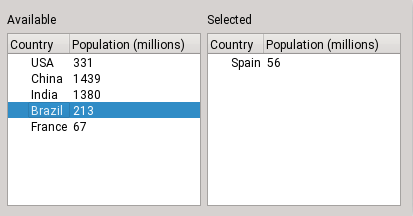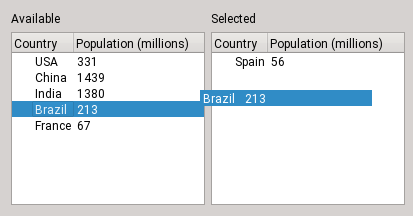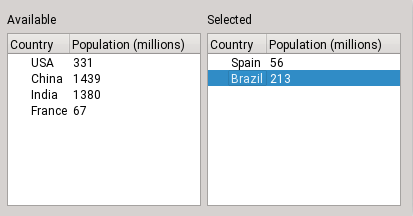Model/View Drag and Drop in Qt - Part 2
Model/View Drag and Drop in Qt - Part 2
In the previous blog, you learned all about moving items within a single view, to reorder them.
In part 2, we are still talking about moving items, and still about inserting them between existing items (never overwriting items) but this time the user can move items from one view to another. A typical use case is a list of available items on the left, and a list of selected items on the right (one concrete example would be to let the user customize which buttons should appear in a toolbar). This also often includes reordering items in the right-side list, the good news being that this comes for free (no extra code needed).

Moving a row between treeviews, step 1

Moving a row between treeviews, step 2

Moving a row between treeviews, step 3
With Model/View separation
Example code for flat models and example code for tree models.
Setting up the view on the drag side
To allow dragging items out of the view, make sure to do the following:
☑ Call view->setDragDropMode(QAbstractItemView::DragOnly) (or DragDrop if it should support both).
☑ Call view->setDragDropOverwriteMode(false) so that QTableView calls removeRows when moving rows, rather than just clearing their cells
☑ Call view->setDefaultDropAction(Qt::MoveAction) so it's a move and not a copy
Setting up the model on the drag side
To implement dragging items out of a model, you need to implement the following:
class CountryModel : public QAbstractTableModel
{
~~~
Qt::ItemFlags flags(const QModelIndex &index) const override
{
if (!index.isValid())
return {}; // depending on whether you want drops as well (next section)
return Qt::ItemIsEnabled | Qt::ItemIsSelectable | Qt::ItemIsDragEnabled;
}
// the default is "return supportedDropActions()", let's be explicit
Qt::DropActions supportedDragActions() const override { return Qt::MoveAction; }
QMimeData *mimeData(const QModelIndexList &indexes) const override; // see below
bool removeRows(int position, int rows, const QModelIndex &parent) override; // see below
};More precisely, the check-list is the following:
☑ Reimplement flags() to add Qt::ItemIsDragEnabled in the case of a valid index
☑ Reimplement supportedDragActions() to return Qt::MoveAction
☑ Reimplement mimeData() to serialize the complete data for the dragged items. If the views are always in the same process, you can get away with serializing only node pointers (if you have that, e.g. for tree models) and application PID (to refuse dropping onto another process). Otherwise you can encode the actual data, like this:
QMimeData *CountryModel::mimeData(const QModelIndexList &indexes) const
{
QByteArray encodedData;
QDataStream stream(&encodedData, QIODevice::WriteOnly);
for (const QModelIndex &index : indexes) {
// This calls operator<<(QDataStream &stream, const CountryData &countryData), which you must implement
stream << m_data.at(index.row());
}
QMimeData *mimeData = new QMimeData;
mimeData->setData(s_mimeType, encodedData);
return mimeData;
}s_mimeType is the name of the type of data (make up a name, it usually starts with application/x-)
☑ Reimplement removeRows(), it will be called after a successful drop. For instance, if your data is in a vector called m_data, the implementation would look like this:
bool CountryModel::removeRows(int position, int rows, const QModelIndex &parent)
{
beginRemoveRows(parent, position, position + rows - 1);
for (int row = 0; row < rows; ++row)
m_data.removeAt(position);
endRemoveRows();
return true;
}Setting up the view on the drop side
☑ Call view->setDragDropMode(QAbstractItemView::DragDrop) (already done if both views should support dragging and dropping)
Setting up the model on the drop side
To implement dropping items into a model (between existing items), you need to implement the following:
class DropModel : public QAbstractTableModel
{
~~~
Qt::ItemFlags flags(const QModelIndex &index) const override
{
if (!index.isValid())
return Qt::ItemIsDropEnabled;
return Qt::ItemIsEnabled | Qt::ItemIsSelectable; // and optionally Qt::ItemIsDragEnabled (previous section)
}
// the default is "copy only", change it
Qt::DropActions supportedDropActions() const override { return Qt::MoveAction; }
QStringList mimeTypes() const override { return {QString::fromLatin1(s_mimeType)}; }
bool dropMimeData(const QMimeData *mimeData, Qt::DropAction action,
int row, int column, const QModelIndex &parent) override; // see below
};☑ Reimplement supportedDropActions() to return Qt::MoveAction
☑ Reimplement flags()
For a valid index, make sure Qt::ItemIsDropEnabled is NOT set (except for tree models where we need to drop onto items in order to insert a first child).
For the invalid index, add Qt::ItemIsDropEnabled, to allow dropping between items.
☑ Reimplement mimeTypes() and return the name of the MIME type used by the mimeData() function on the drag side.
☑ Reimplement dropMimeData()
to deserialize the data and insert new rows.
In the special case of in-process tree models, clone the dragged nodes.
In both cases, once you're done, return true, so that the drag side then deletes the dragged rows by calling removeRows() on its model.
bool DropModel::dropMimeData(const QMimeData *mimeData, Qt::DropAction action, int row, int column, const QModelIndex &parent)
{
~~~ // safety checks, see full example code
if (row == -1) // drop into empty area = append
row = rowCount(parent);
// decode data
const QByteArray encodedData = mimeData->data(s_mimeType);
QDataStream stream(encodedData);
QVector<CountryData> newCountries;
while (!stream.atEnd()) {
CountryData countryData;
stream >> countryData;
newCountries.append(countryData);
}
// insert new countries
beginInsertRows(parent, row, row + newCountries.count() - 1);
for (const CountryData &countryData : newCountries)
m_data.insert(row++, countryData);
endInsertRows();
return true; // let the view handle deletion on the source side by calling removeRows there
}Using item widgets
Example code can be found following this link.
For all kinds of widgets
On the "drag" side:
☑ Call widget->setDragDropMode(QAbstractItemView::DragOnly) or DragDrop if it should support both
☑ Call widget->setDefaultDropAction(Qt::MoveAction) so the drag starts as a move right away
On the "drop" side:
☑ Call widget->setDragDropMode(QAbstractItemView::DropOnly) or DragDrop if it should support both
☑ Reimplement supportedDropActions() to return only Qt::MoveAction
Additional requirements for QTableWidget
When using QTableWidget, in addition to the common steps above you need to:
On the "drag" side:
☑ Call item->setFlags(item->flags() & ~Qt::ItemIsDropEnabled); for each item, to disable dropping onto items.
☑ Call widget->setDragDropOverwriteMode(false) so that after a move the rows are removed rather than cleared
On the "drop" side:
☑ Call widget->setDragDropOverwriteMode(false) so that it inserts rows instead of replacing cells (the default is false for the other views anyway)
☑ Another problem is that the items created by a drop will automatically get the Qt::ItemIsDropEnabled flag, which you don't want. To solve this, use widget->setItemPrototype() with an item that has the right flags (see the example).
Additional requirements for QTreeWidget
When using QTreeWidget, you cannot disable dropping onto items (which creates a child of the item).
You could call item->setFlags(item->flags() & ~Qt::ItemIsDropEnabled); on your own items, but when QTreeWidget creates new items upon a drop, you cannot prevent them from having the flag Qt::ItemIsDropEnabled set. The prototype solution used above for QTableWidget doesn't exist for QTreeWidget.
This means, if you want to let the user build and reorganize an actual tree, you can use QTreeWidget. But if you just want a flat multi-column list, then you should use QTreeView (see previous section on model/view separation).
Addendum: Move/copy items between views
If the user should be able to choose between copying and moving items, follow the previous section and make the following changes.
With Model/View separation
On the "drag" side:
☑ Call view->setDefaultDropAction(...) to choose whether the default should be move or copy. The user can press Shift to force a move, and Ctrl to force a copy.
☑ Reimplement supportedDragActions() in the model to return Qt::MoveAction | Qt::CopyAction
On the "drop" side:
☑ Reimplement supportedDropActions() in the model to return Qt::MoveAction | Qt::CopyAction
The good news is that there's nothing else to do.
Using item widgets
On the "drag" side:
☑ Call widget->setDefaultDropAction(...) to choose whether the default should be move or copy. The user can press Shift to force a move, and Ctrl to force a copy.
Until Qt 6.10 there was no setSupportedDragActions() method in the item widget classes (that was QTBUG-87465, I implemented it for 6.10). Fortunately the default behavior is to use what supportedDropActions() returns so if you just want move and copy in both, reimplementing supportedDropActions() is enough.
On the "drop" side:
☑ Reimplement supportedDropActions() in the item widget class to return Qt::MoveAction | Qt::CopyAction
The good news is that there's nothing else to do.
Improvements to Qt
While writing and testing these code examples, I improved the following things in Qt:
- QTBUG-1387 "Drag and drop multiple columns with item views. Dragging a row and dropping it in a column > 0 creates multiple rows.", fixed in 6.8.1
- QTBUG-36831 "Drop indicator painted as single pixel when not shown" fixed in 6.8.1
- QTBUG-87465 ItemWidgets: add supportedDragActions()/setSupportedDragActions(), implemented in 6.10
Conclusion
In the next blog post of this series, you will learn how to move (or copy) onto existing items, rather than between them.
The post Model/View Drag and Drop in Qt - Part 2 appeared first on KDAB.